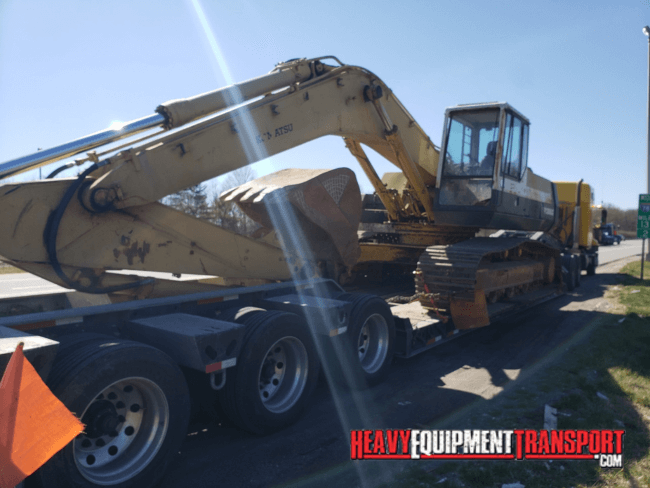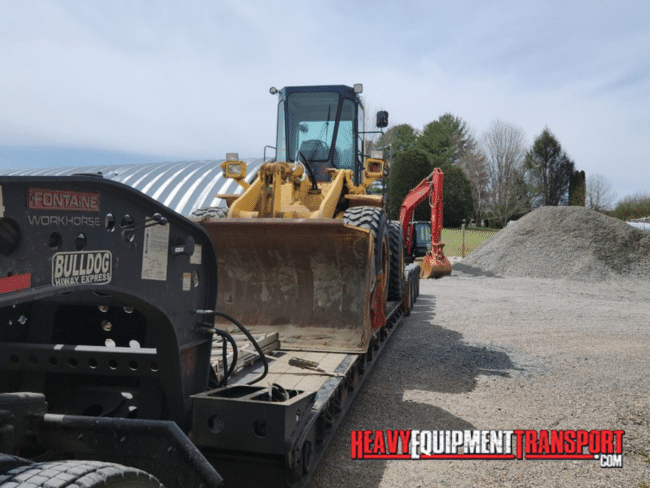Safety Tips for Transporting Construction Equipment

Francisca Olive / June 2023
Safely shipping construction equipment is no easy feat. It always calls for meticulous preparation and recognizing potential obstacles that may cause an unforeseen mishap. Even a seemingly insignificant mistake can have catastrophic results, putting the lives of your employees and the functionality of their equipment at risk. Read on to learn more about safely transporting construction equipment.
Choosing The Right Method of Transportation
Construction equipment is heavy, so it is essential to choose the proper transport methods to get it to and from the site without damaging it.
Some ways to transport construction equipment include:

➤ Towing
Towing is the best choice for short-distance transport of construction equipment. Make sure your equipment is ready to be towed by inspecting the gearbox and tires. Be sure the vehicle you’re using to haul your gear can also do the job. Inspecting the tires, load capacity, and overall vehicle safety is important.
➤ Flatbeds
Flatbed trailers are semitrailers that sit on wide wheels. They are frequently used to transport construction equipment due to their reliability and capacity to carry heavy loads. Flatbeds provide a level surface, making loading and unloading heavy machinery easier.
➤ Special Trailers
Certain pieces of construction equipment are considerably bigger and heavier than others. Such massive machinery requires specially designed trailers like step decks or double drops.
Transport Your Construction Equipment Today
Heavy Equipment Transport is always available for a quote. Fill out the form or give us a call now! (888) 730-2951
Comply With Regulations
Always eliminate any extraneous attachments that might make your equipment too heavy or large to avoid getting the oversize designation status (and the added stress that comes with it). Shipping everything at once can seem smart, but sending items separately is often less expensive and more convenient.
Hire a Heavy Equipment Transport Company
Hiring a professional heavy equipment transport company is the most efficient method of moving heavy machinery to and from a building site. You can’t trust just any moving firm with transporting your machinery. The chosen transport company should be up to par and well-known in the field.
To choose the finest moving company, look at its insurance, the range of services it provides, its integrity, and its reputation. Using a moving firm means reduced risk of harm to your machinery since they have trained employees, the appropriate equipment, and safety standards to ensure your machines get to the site without incident.
Furthermore, the firm will pay for damage to your equipment if an incident occurs. Thus, it is crucial to verify that they have enough insurance coverage. Using a transport firm is economical since you won’t have to spend money on renting or purchasing trailers to move your machinery. Also, you won’t have to worry about spending money fixing anything that breaks while being transported.

Prepare Equipment for Transport
Before loading the equipment onto the trailer, consider the many issues that may arise. Is there anything that might get damaged during transport? Then it’s best to get rid of it or cover it with bubble wrap if that’s the case.
● Remove the battery if you need the machine to start when it reaches its destination.
● Close and latch all doors correctly, as they might open and flap during shipping if not secured.
● Inspect your equipment and clean it if necessary. This may be the last thing on your mind, but having clean construction equipment will make it easy to tell if something was damaged during transport.
Ensure The Equipment is Secured to the Trailer
This may seem like common sense, but it bears repeating in light of the shockingly high number of deaths in the construction industry. While loading equipment onto a trailer, it’s essential to double-check that everything is secure and in the right place.
The risks associated with the load, including the well-being of your employees and the driver, fall squarely on your shoulders. For instance, if you ship dangerous chemicals and some or all of the contents leak, you might put a whole ecosystem at risk.
You can consult the Federal Motor Carrier Safety Administration if you are unsure about safely transporting construction equipment. Check fmcsa.dot.gov often to ensure you comply with the requirements since they may differ from state to state.
Plan The Route
A well-planned route is essential for safely transporting construction equipment. Especially in more rural places, most of us have been told tales or seen videos of vehicles that are too heavy or too large to go under electricity lines or too tall to fit under bridges.
If you want to ensure your equipment gets where it has to go safely, you should steer clear of routes with small roads, bridges with overpasses, and weight limits. Choose a route that is easy to navigate, with a minimum number of turns, bridges starts, stops, and challenging terrain.
Key Takeaway
You should read this list several times to ensure you haven’t missed anything. Review all applicable safety standards before shipping any large pieces of construction equipment. Do not leave anything to chance; instead, carefully plan everything.

William Thomas
Heavy Transport Specialist
Being able to lead a team of such talented logistics agents has been a wonderful experience over the past ten years. If you would like to know anything more about the heavy equipment transport services we offer, don't hesitate to give us a call!